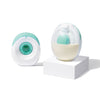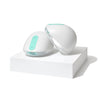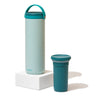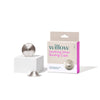What you need to know about properly defrosting your freezer stash — you worked hard for this milk!
If you’re building a freezer stash, learning how to properly thaw your breast milk for safe consumption is critical. You worked hard for this milk — and defrosting it the right way will ensure that you preserve nutrients, prevent bacterial growth, and avoid having to toss it.
In this article, we’ll cover:
- The importance of proper breast milk thawing
- Potential risks of improper breast milk thawing
- Ways to thaw breast milk
- Ways to reheat breast milk
- Proper breast milk handling and storage guidelines
Ready to start making those bottles? Let’s get into it!
Why Correct Thawing of Breast Milk is Essential
Taking the time to thaw your breast milk the right way is essential. Not only will it help you preserve important macronutrients, vitamins, and minerals, it will also prevent bacterial growth and ensure that your milk is safe for your baby. Unfortunately, bacteria can grow and spread in breast milk pretty quickly if it isn’t handled properly!
Different Ways to Thaw Breast Milk
You’ll know that your breast milk is fully thawed when it is liquid and chilled. It’s okay if you notice a couple of remaining ice crystals — these will likely dissolve quickly once your milk is poured into a bottle.
You should always thaw your oldest breast milk first. Keep this in mind when you’re storing your pumped milk in the freezer! You’ll want to make sure that the oldest milk is easily accessible and that you can clearly view the date that your milk was expressed.
Thawing in the Refrigerator
Thawing breast milk in the refrigerator can take between 4 and 12 hours, so it’s important to plan in advance!
Place your milk storage bag in the fridge standing upright. Make sure that it’s not squished between any containers that could puncture or damage the bag.
The benefit of thawing your milk this way? Once it’s fully defrosted, it can remain in the fridge for up to 24 hours, giving you a bit of flexibility.
Thawing in Warm Water
You can also thaw your breast milk by covering it with a stream of warm running water. Just make sure that the temperature is no higher than 99 degrees! If it’s boiling, you could end up damaging the milk’s nutritional properties, or create “hot spots” that burn your baby’s mouth once the milk has been transferred to a bottle.
You can also place the bag in a bowl of warm water, swirling gently to speed defrosting and to make sure that the fatty parts of the milk (which may separate when frozen) are incorporated.
Remember that defrosted milk can only remain at room temperature for two hours before it must be used — so if you place the bag in a bowl of water, try not to forget about it!
Avoiding Microwave & Room Temp Thawing
For the same reasons that you’ll want to avoid defrosting your milk under a stream of boiling water, you’ll want to stay away from thawing in the microwave. Temperatures that are too high could lead to nutrient loss and put your baby at risk of burning their mouth due to uneven heating!
You’ll also want to stay away from thawing your milk on the kitchen counter or at room temperature. It’s too hard to control the temperature of your environment, and not worth exposing your baby to potential bacteria!
Reheating Thawed Breast Milk
Many babies don’t like cold breast milk — so once you’ve thawed yours, there are a few ways that you can warm it up if your baby prefers that.
Using a Bottle Warmer
You can use a bottle warmer, which involves placing your bottle into a chamber surrounded by water, to get your breast milk to a more comfortable temperature.
After removing your bottle from the warmer, you’ll always want to test the temperature of the milk by squeezing a few drops onto the back of your hand to make sure that it’s not too hot.
Warm Water Method
You can also hold your bottle under a stream of water, or place it in a bowl of warm water, to get the chill off. Similar to the guidelines for defrosting breast milk this way, just make sure that the water is not boiling — this could create hot spots that scald your baby’s mouth.
Checking the Temperature
You’ll want your warmed breast milk to be about 98.6°, or body temperature, before feeding it to your baby. Swirling the bottle after warming the milk can help ensure you’ve warmed the milk can help ensure that the temperature is even throughout.
Handling and Storage of Thawed Breast Milk
Storage Guidelines
Store your thawed breast milk in the refrigerator for no more than 24 hours, or at room temperature (defrosting it in a bowl of warm water falls into this category!) for no more than two hours. Set a timer or label the bag with the date and time once you’ve started the thawing process if you need a little reminder!
Tip: try freezing your milk in smaller quantities for quicker thawing and minimal wastage for quicker thawing and minimal wastage, try freezing your milk in smaller quantities. You can always thaw two bags at once and combine the milk if you need more!
Avoiding Refreezing
Refreezing breast milk once it has been thawed is not recommended and should be avoided — even if it means pouringthat you need to pour some of your milk down the drain. (We know, it’s painful!) Just like improper thawing the first time around, this can increase the chances of bacteria growth and damage your milk’s nutritional properties. It’s not worth the risk for your baby.
Tips for Ensuring Quality and Safety of Thawed Breast Milk
When storing, thawing, transferring, and mixing your breast milk, it’s important to take steps to ensure quality and safety.
Using Clean Containers
Only store your milk in sterilized, single-use storage bags, and make sure to thaw them in clean areas of your refrigerator or clean bowls filled with water. You do not want open containers of food or beverages near your milk when it’s thawing!
Gentle Mixing
There is no evidence to support the claim that shaking your thawed breast milk too vigorously can damage the milk’s nutritional properties. However, swirling it gently to make sure that any of the fat that separated during the defrosting process is re-incorporated is recommended — you don’t want to risk breaking or bursting the storage bag!
Regular Monitoring
After thawing your breast milk, it’s important to make sure that it looks and smells fresh.
The consistency should not be clumpy, stringy, or covered in scum, and it should not smell fishy or rancid — if you do notice this smell, some chemical oxidation has likely taken place. When swirled or shaken, the fat content should re-incorporate easily. If it doesn’t, it’s unfortunately time to toss it out.
It is normal for the milk to separate a bit, and to be tinted slightly yellow, blue, or green. A small percentage of moms may notice a somewhat sour, soapy scent once it is thawed; this is not harmful to your baby. The smell is due to the presence of lipase, which is an enzyme that helps break down fats. For these moms, when breast milk is kept at room temperature or in the refrigerator, their active lipase enzyme will create a stronger scent. The longer this breast milk is stored, the more lipase activity will occur.
Ensuring Safe and Nutritious Feeding with Willow
Remember that proper thawing techniques will ensure that you prevent the growth of bacteria and maintain your breast milk’s nutritional value.
Here’s a recap of what you know about safely thawing your breast milk:
- You can thaw your milk in the fridge, by holding it under warm running water, or by submerging it in a warm bowl
- Once milk has been thawed, it can remain in the fridge for up to 24 hours, or at room temperature for up to two hours in it’s proper milk storage container
- Milk should never be thawed at room temperature, in the microwave, or in boiling water
- Milk that has been thawed should never be re-frozen
- If you notice that your thawed milk smells rancid, looks clumpy, or won’t mix easily when shaken, it’s time to toss it out
For more tips about safe milk storage, check out the Pumping and Breastfeeding section on our blog.
Thawing Breast Milk FAQs
- The safest way to thaw frozen breast milk is by placing it in the refrigerator for 4 to 12 hours. You can also thaw it quickly by placing the milk under warm running water or in a bowl of warm water, ensuring the water isn’t hotter than 99°F to preserve nutrients and avoid hot spots.
- Once breast milk is thawed, it can be stored in the refrigerator for up to 24 hours or left at room temperature for no more than two hours. Avoid refreezing thawed breast milk to prevent bacterial growth and nutrient loss.
- Thawing breast milk in the microwave is not recommended because it can cause uneven heating, create hot spots that could burn your baby, and lead to a loss of important nutrients in the milk.
Tags Used





